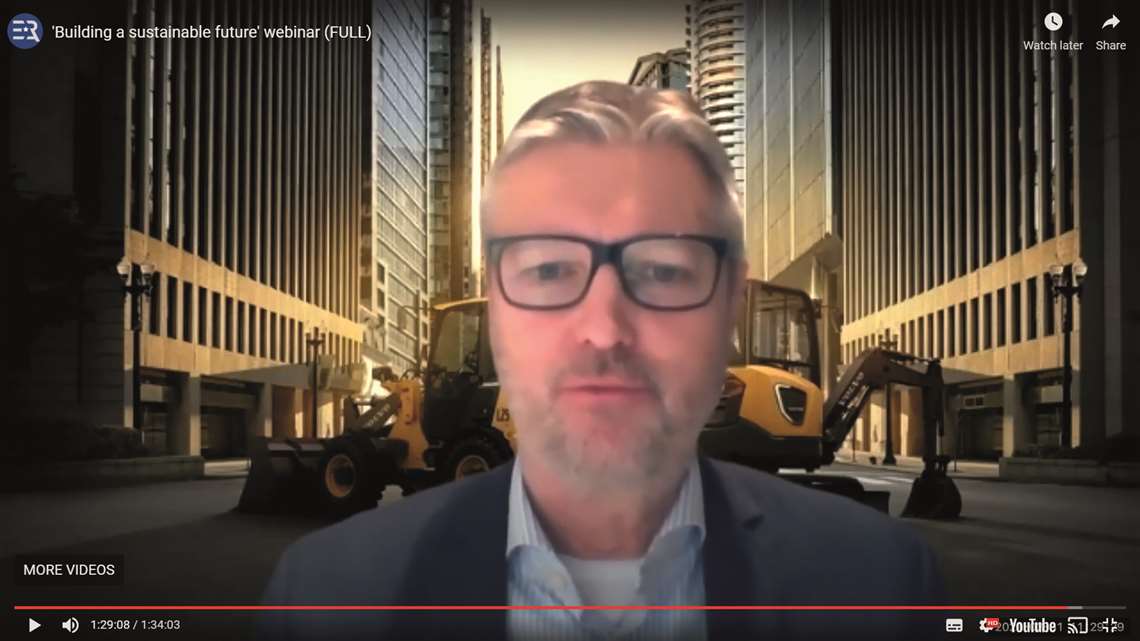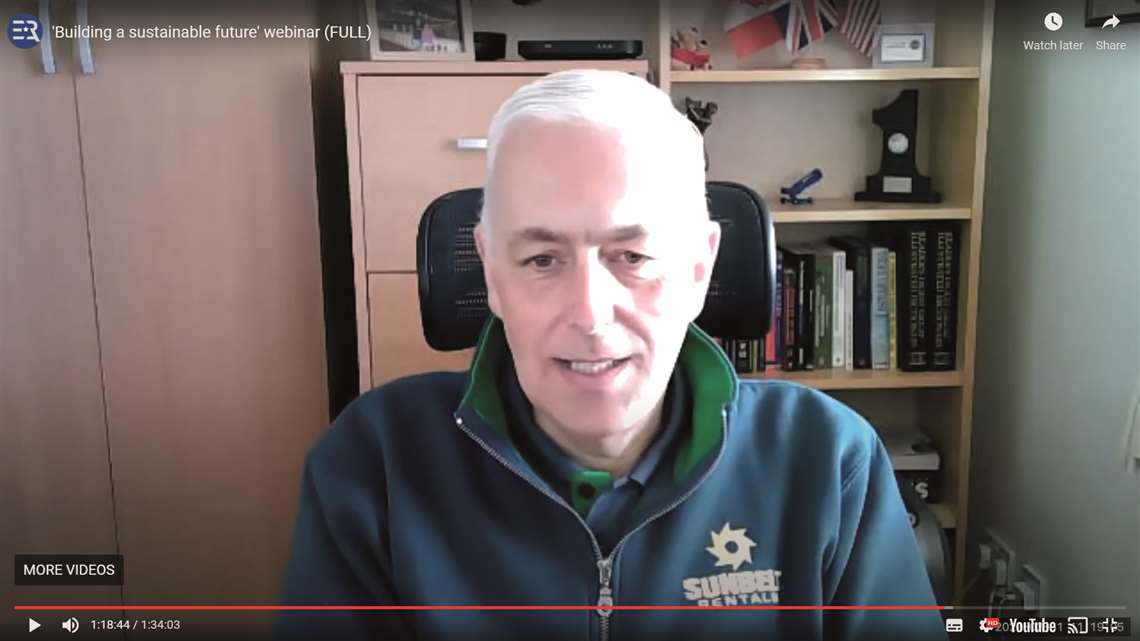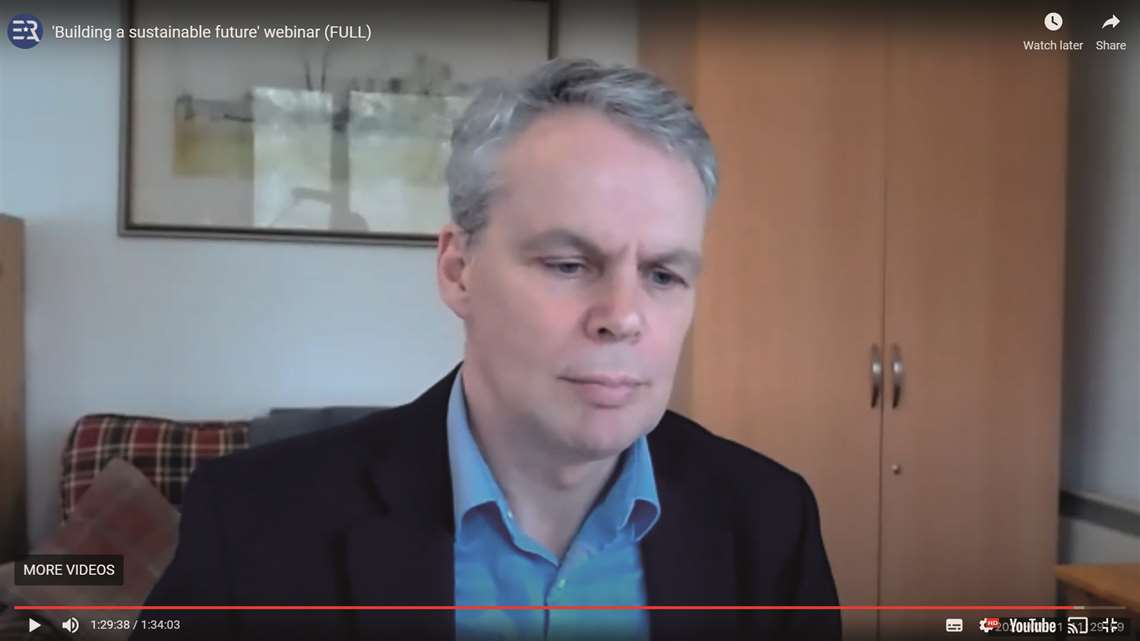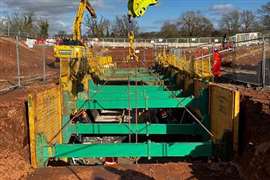The role of rental in sustainability
27 April 2021
The European Rental Association held an online sustainability event on 31 March. This is an edited version of the round-table discussion, moderated by IRN’s Murray Pollok.
A full recording of the ERA sustainability event, which also included contributions from EU policy experts and politicians, can be viewed here.
Murray Pollok (MP): Is the construction industry doing enough on sustainability?
Sue Arundale, FIEC: We could be moving faster, but there are some barriers. First of all we have a lack of availability of secondary [recycled] materials.
 Sue Arundale, Technical and Environmental Affairs, FIEC (European Construction Industry Federation)
Sue Arundale, Technical and Environmental Affairs, FIEC (European Construction Industry Federation)
Sometimes we have shortages and sometimes have problems with quality, and sometimes we are not even allowed to use secondary materials because the buyer does not want us to.
Second, we have the question of standards and regulations.
There are gaps in terms of secondary materials and as the burden of responsibilities on the contractor.
Contractors need reassurance about these materials and there are also issues around safety and around fire risk and toxicity. We could be going faster, of course, but there are lots of reasons, lots of mitigating factors in this.
Contractors do take it seriously…The larger contractors in particular have very ambitious goals, so they are very committed to the principle of sustainability.
Peter Jodansson, Volvo CE: I think it’s hard to say that anyone is moving quickly enough, but we need to be aware about this is a huge transformation in the whole society and the construction sector has an important role to play in this.
But my answer on that is also that change take time.
Douglas McLuckie, Ashtead: I think there is a huge challenge between now and the 2040-2050 scenario within the Paris Climate Agreement.
I think that [one issue] is clients’ willingness to pay for better, more advanced technology.
For me, looking at some of the blue-chip clients, they are absolutely at the top of their game when it comes to sustainability and they are willing to pay that premium to ensure sustainability and the overall build cost of a project. Some clients just haven’t quite grasped that concept yet.
MP: Is the rental industry doing enough?
Michel Petitjean, ERA: There is our CO2 calculator, but we have developed quite a few other projects over the last three to five years.
We have a sustainable supplier framework, which is an attempt to help any stakeholder to evaluate their equipment suppliers, the OEMs, when it comes to sustainability.
And we developed that with all the companies involved, including service companies like rental companies, but also contractors and OEMs.
We have another project, CSR [Corporate Social Responsibility] KPIs. We used consultants to go through all our rental companies and also contractors to analyse and list the main parameters influencing CSR policies.
We have developed a list of parameters indicating minimum requirements, good practice and, for the leading operators, some best practices.
MP: Are contractors encouraging their supply chain to operate sustainably?
Sue Arundale, FIEC: Sometimes this depends on the demands of the client and architect in terms of the choice of materials. However, I mentioned that large contractors do have ambitious goals for sustainability and indeed these contractors do have influence, particularly the bigger ones.
The smaller contractors have more difficulty in influencing their supply chains, but definitely the desire and the will is there.
MP: what is Volvo’s strategy on sustainable products?
 Peter Jordansson, SVP Purchasing, Volvo Construction Equipment
Peter Jordansson, SVP Purchasing, Volvo Construction Equipment
Peter Jordansson, Volvo CE: We are actively working with sustainability and circularity, of course. For us they are on the top of the agenda for sure and embedded in our purpose to build a better world. So, we have set up very strong ambitions for ourselves.
We talk about the Paris Agreement alignment, we are talking about science-based targets, electrified machines and concepts. We launched some electrified products in November last year; compact excavators and compact wheeled loaders.
We are producing one of these each per day now, so you can talk about an annual volume of 400 to 500. I think that we need to step up [in volumes], but change takes time.
MP: what about larger machines?
Peter Jordansson, Volvo CE: That needs to be developed now and fuel cells are the way to go here, but it’s not developed enough at this big scale yet. The rule of thumb is hydrogen for the bigger machines and batteries for the smaller machines.
MP: Douglas, is it a challenge for Ashtead to switch away from diesel?
 Douglas McLuckie, Managing Director, Environmental, Social and Governance (ESG), Ashtead Group
Douglas McLuckie, Managing Director, Environmental, Social and Governance (ESG), Ashtead Group
Douglas McLuckie, Ashtead: In terms of the switch from traditional combustion engines to electrification, I see a perfect storm on the horizon and the challenge of electricity supply.
If we’re not careful, we’re going to run out of capacity on the electricity grid to make sure we can not only charge rental assets but charge delivery assets as well. When you look at the size of our fleet, we have a huge, electrified fleet at this moment in time. We need to map carefully any new facilities we have with regards to the electricity supply that’s coming in.
It’s also worth noting that there is still life left in diesel. Although we have lots of blue-chip customers, we also satisfy the needs of smaller companies that support local infrastructure and local communities. They’re not willing to pay the extra premium for that electrified product, so there is still life in diesel.
As Peter touched on, hydrogen will be a fuel of the future and not just in the larger machines. They will be available in the smaller machines also.
We have influence with the OEMs to ensure there is a steady pace of new and innovative technologies coming through.
MP: are the OEMs doing enough?
Douglas McLuckie, Ashtead: Absolutely. There is no doubt about it. There is almost no R&D budget for the smaller internal combustion engines. That’s almost gone across all of the manufacturers we deal with.
From the perspective of smaller tools, that transition already happened three or four years ago. We are now looking at the two and a half tonne upwards machines. But once again I see that perfect storm: we need to make sure there’s capacity in electricity supply to support both those types of assets and charging.
MP: how will the ERA’s CO2 calculator be developed?
 Michel Petitjean, Secretary General, European Rental Association
Michel Petitjean, Secretary General, European Rental Association
Michel Petitjean, ERA: I would qualify it as a rough calculator because after three years of working we have defined very solid parameters and elements of what constitutes the total carbon footprint equipment and we now have to go back and work hard at complementing and refining it.
We have to add the impact of production in different countries, especially for batteries and so on. It is also based on operating hours, but we have to consider idle hours, because they may represent up to 40 to 50% of the total running hours. We have to distinguish the type of energy in charging; we have to account for hybrid machines and alternative fuels, and we have to enter deep into maintenance.
The surprise is that from the feedback we had, some world leading manufacturers are using it daily, so everybody is involved. It’s like our total cost of ownership (TCO) calculator, we have one third contractors, one third of suppliers and one third OEMs.
MP: what is Ashtead’s approach to measuring its CO2 emissions?
Douglas McLuckie, Ashtead: We have managed and measured those for over 10 years now and also publicly report under the carbon disclosure project. With regards to our customers’ usage of the equipment and Scope 3 emissions, we are now engaged on a program to measure our Scope 3 emissions, so we can understand the upstream and downstream impacts and report them as part of our strategy.
We absolutely measure Scope 1 and Scope 2 emissions, and report publicly on them, and we are now looking at Scope 3 emissions and the use of the equipment itself, as well as the manufacturing; basically the whole life cycle impact of the asset.
MP: what impact will the pandemic have on investment in sustainability?
 Moderator: Murray Pollok, Managing Editor, IRN
Moderator: Murray Pollok, Managing Editor, IRN
Sue Arundale, FIEC: Honestly, I don’t think this is a question of the pandemic. It’s changing because of the legislative framework. The green deal; the revision of the energy performance of buildings directive.
We’re expecting a carbon price for the use phase of buildings and they’re revising the construction products regulation. When you add on top of this that sustainable finance will be subject to tax criteria, this is a really big thing that’s happening right now. It is going to have a massive impact in terms of what is financed what is subsidised. Things are going to change dramatically.
Peter Jordansson, Volvo CE: I agree, but maybe the pandemic was an eye opener or pushed it a little bit further.
Michel Petitjean, ERA: First, rental is an asset-based business. It takes two Euros to generate one Euro revenue, so it’s a very heavily capitalised business. Rental companies have coped quite well throughout the crisis so far, in trying to keep their assets current and working. They are ready to work when demand comes back and they will wait as long as it takes.
We have [also] noticed that the situation of companies is very different based on the different countries and depending on the way the pandemic has been managed by the authorities. Some countries have maintained construction work through the crisis, and that has meant some differences for the year 2020. We’ll see for 2021.
Douglas McLuckie, Ashtead: I think society has changed significantly over the pandemic and one light at the end of the tunnel that will come out of it is that we all have a different mindset when it comes to sustainability.
Peter touched on it, and for me this started four or five years ago with the sustainability push. I think the pandemic has accelerated it.
Clearly the rental model is in absolutely prime position to support cash conservation [for customers]. When it comes to pent-up demand to build out as we grow more sustainably, what better way to do it than support the rental model and conserve your cash?
STAY CONNECTED



Receive the information you need when you need it through our world-leading magazines, newsletters and daily briefings.
CONNECT WITH THE TEAM












